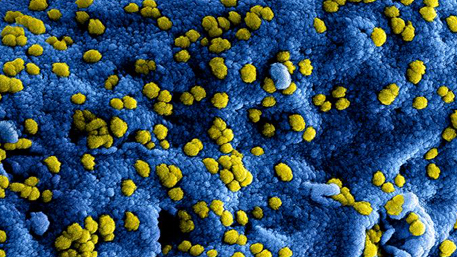
The Importance of Long-term Care Populations in Models of COVID-19
K Pillemer et al, JAMA, June 5, 2020
K Pillemer et al, JAMA, June 5, 2020
Both modelers and public health policy makers should recognize that COVID-19 is not a unitary epidemic. It likely consists of multiple, contemporaneous, and intertwined sub-outbreaks prominently including those in long term care settings. Just as the outbreaks occurring in these 2 settings are distinct, the responses to them need to differ.
Targeting SARS-CoV-2 Receptors as a Means for Reducing Infectivity and Improving Antiviral and Immune Response: An Algorithm-based Method For Overcoming Resistance To Antiviral Agents.
Gelman Ram et al. Emerging microbes & infections 2020 Jun 1-21
Gelman Ram et al. Emerging microbes & infections 2020 Jun 1-21
Genetic polymorphisms mediating behavioural and immune response to pathogens may moderate the impact of the COVID-19 pandemic: a pilot study
RP Rakjumar, MEDRXIV< June 4, 2020
RP Rakjumar, MEDRXIV< June 4, 2020
A prediction model based on machine learning for diagnosing the early COVID-19 patients
SN Nan et al, MEDRXIV June 4, 2020
SN Nan et al, MEDRXIV June 4, 2020
Swab Tests and COVID 19, Italy case studied using Artificial Intelligence, Statistical Analysis and MLR
B Pirouz et al, MEDRXIV, June 4, 2020
B Pirouz et al, MEDRXIV, June 4, 2020
COVID-19 genomic susceptibility: Definition of ACE2 variants relevant to human infection with SARS-CoV-2 in the context of ACMG/AMP Guidance
CL Shovlin et al, MEDRXIV, June 4, 2020
CL Shovlin et al, MEDRXIV, June 4, 2020
Risk factors for mortality in patients with Coronavirus disease 2019 (COVID-19) infection: a systematic review and meta-analysis of observational studies
M Parohan et al MEDRXIV, June 4, 2020
M Parohan et al MEDRXIV, June 4, 2020
14 studies with 29,909 COVID-19 infected patients and 1,445 cases of death were included in the current meta-analysis. Older age (=65 years old), male gender, hypertension, CVDs, diabetes, COPD and malignancies were associated with greater risk of death from COVID-19 infection.
Machine learning in predicting respiratory failure in patients with COVID-19 pneumonia - challenges, strengths, and opportunities in a global health emergency
D Ferrari et al, MEDRXIV, June 3, 2020
D Ferrari et al, MEDRXIV, June 3, 2020
Using viral genomics to estimate undetected infections and extent of superspreading events for COVID-19
LM Li et al, MEDRXIV, June 3, 2020
LM Li et al, MEDRXIV, June 3, 2020
Using a Bayesian inference framework to fit a branching process model to viral phylogeny and time series case data, we estimated time-varying reproductive numbers and their variance, the total numbers of infected individuals, the probability of case detection over time, and the estimated time to detection of an outbreak for 12 locations in Europe, China, and US.
Uncertainty Quantification in Epidemiological Models for COVID-19 Pandemic
L Taghizadeh et al, MEDRXIV, June 3, 2020
L Taghizadeh et al, MEDRXIV, June 3, 2020
HiDRA-seq: High-Throughput SARS-CoV-2 Detection by RNA Barcoding and Amplicon Sequencing
E Yanguez et al, BIORXIV, June 2, 2020
E Yanguez et al, BIORXIV, June 2, 2020






















.png)











No hay comentarios:
Publicar un comentario